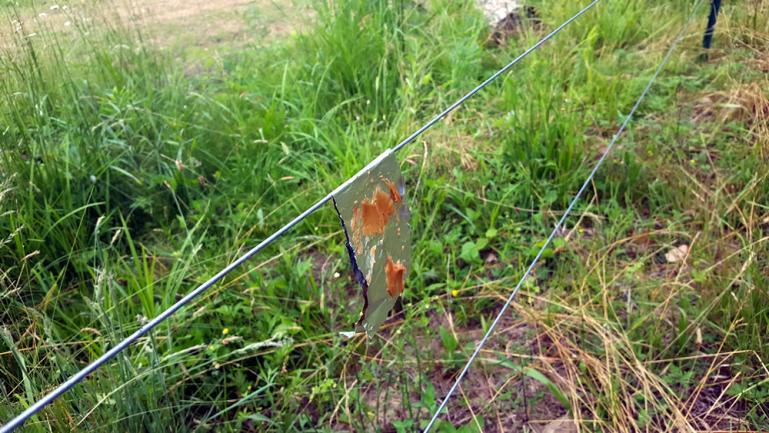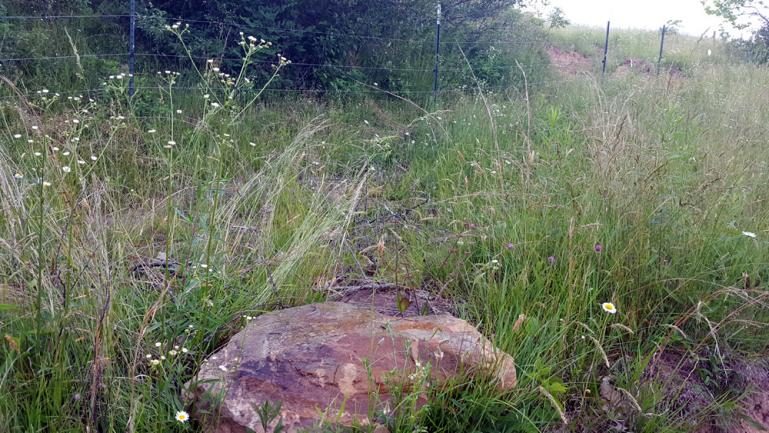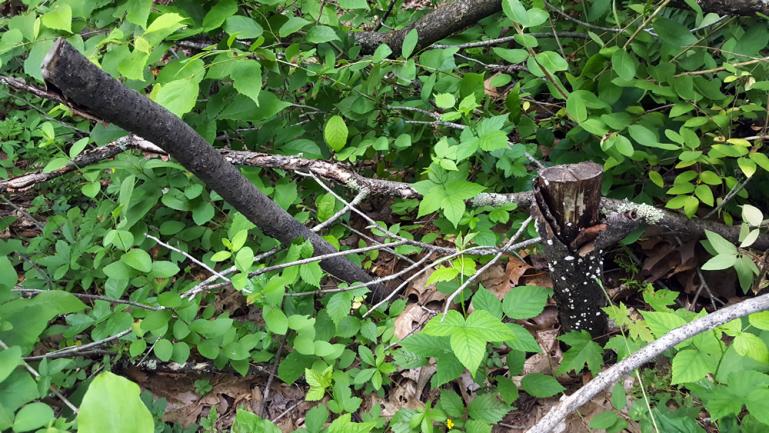Invasive Species
by Gianni on our previous farm
Since most of our garden spaces are built on permaculture practices we have multiple areas and scattered terraced beds instead of row crops with the exception of this years sorghum & bean field. This make varmint control and weeding a little extra difficult.
Deer/rabbit fencing our garden would be very expensive and make the farm look like a juvie prison so we employ a variety of means to repel the mole, rabbit, ground hog and deer. The most effective means for all these varmints is a loose dog with a good nose and work ethic named Pepper. Since our planting areas are as much as a quarter mile apart, we also use several more techniques for deer repellant. This years favorite is the good ole "peanut butter on tin foil hanging on an electric fence" trick. I learned of this from a WVU Ag Dept research prof at the WV Small Farms Conference. He swore by it for training deer to respect an electric fence. I wish I could put game cameras up to capture their cute little faces when they taste the peanut butter.
Strong human scent in the gardens are also good deterrent so I mark rocks as often as possible and stinky work clothes left in the garden provide plenty of human scent for a few days. We also practice planting deer resistant crops on the borders and scattered through out the gardens,
Each of these means by itself would not be enough, combined they help keep the varmints guessing and hesitant.
We discovered one deer/rabbit repellant that claimed to be safe for plants and pets. The directions tell you to lightly coat the whole plant to protect it But To Not Use It On Edible Plants....
We have a large number of fields over run with Sumac trees and I've discovered a new, organic means of killing them where they're really not wanted. If you just cut the tree off a few weeks later it will have sprouted new branches and come back to life. After being told repeatedly by several people that I should go get some monsanto poison, cut the tree off and coat the stump with the poison; it dawned on me that vegetable oil in sufficient quantities will also kill plants. it suffocates the plant. Over the course of a year the veggie oil breaks down to fertilize the earth. So last summer I cut down some nuisance Sumac and coated the cut and the remaining stump with veggie oil. They are still dead, no new off shoots and there are plenty of other plants growing around them. Poison is expensive, you can generally get used restaurant veggie oil for free (from the mom & pop restaurants). I will be doing a lot more of this Sumac clearing now that I know it works. I want to leave many extremely tall stumps in the ground and try to use them for trellising.
The land here is also host to several of the most notorious invasive weeds. Japanese Knot Weed, Ragweed, Kudzu, Autumn Olive, Lambs Quarter, Perilla, Dandelion, Multiflora Rose, Honeysuckle, Chickweed ... we got'm. While researching eradication methods for many of these plants we discovered that many of them are at least partially edible and generally of much higher nutritional value than "conventional" food. I have been hoping to make more time to harvest these free, nutritious invasives and some of them are becoming a normal part of our daily diet. Today I learned that there's already a "movement" to eat the invasives as a means of eradicating them.
Invasivorism
Invasive species are flora and fauna whose introduction into a habitat disrupts the native eco-system. In response, Invasivorism is a movement that explores the idea of eating invasive species in order to control, reduce, or eliminate their populations. Chefs from around the world have begun seeking out and using invasive species as alternative ingredients. Miya's of New Haven, Connecticut created the first invasive species menu in the world.[55] Proponents of invasivorism argue that humans have the ability to eat away any species that it has an appetite for, pointing to the many animals which humans have been able to hunt to extinction - such as the Dodo bird, the Caribbean monk seal, and the Passenger pigeon. Proponents of invasivorism also point to the success that Jamaica has had in significantly decreasing the population of lionfish by encouraging the consumption of the fish.[57]
So we're invasivor curious right now... there's so much to learn.














Comments
John pisapia
Sat, 06/04/2016 - 16:11
Permalink
Well written piece. Very
incognito
Sun, 06/05/2016 - 06:33
Permalink
It's good to know that the
Colin
Mon, 08/22/2016 - 14:54
Permalink
Japanese Knot Weed is used by
Art
Tue, 08/23/2016 - 09:37
Permalink
I'd forgotten about that.
Chappell
Wed, 10/05/2016 - 16:48
Permalink
"every time you hear the word